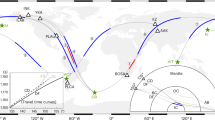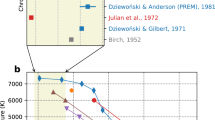Abstract
Differential rotation of the Earth's inner core has been inferred by several seismic ‘body-wave’ studies1,2,3,4,5,6 which indicate that the inner core is rotating at a rate between 0.2° and 3° per year faster than the Earth's crust and mantle. The wide range in inferred rotation rate is thought to be caused by the sensitivity of body-wave studies to local complexities in inner-core structure3,7. Free-oscillation ‘splitting functions’, on the other hand, are insensitive to local structure and therefore have the potential to estimate differential rotation more accurately. A previous free-oscillation study8, however, was equivocal in its conclusions because of the relatively poor quality and coverage of the long-period digital data available 20 years ago. Here we use a method for analysing free oscillations9 which is insensitive to earthquake source, location and mechanism to constrain this differential rotation. We find that inner-core differential rotation is essentially zero over the past 20 years (to within ±0.2° per year), implying that the inner core is probably gravitationally locked to the Earth's mantle10.
This is a preview of subscription content, access via your institution
Access options
Subscribe to this journal
Receive 51 print issues and online access
$199.00 per year
only $3.90 per issue
Buy this article
- Purchase on Springer Link
- Instant access to full article PDF
Prices may be subject to local taxes which are calculated during checkout




Similar content being viewed by others
References
Song,X. & Richards,P. G. Seismological evidence for differential rotation of the Earth's inner core. Nature 382, 221–224 (1996).
Su,W., Dziewonski,A. M. & Jeanloz, R. Planet within a planet: rotation of the inner core of the Earth. 274, 1883–1887 (1996).
Creager,K. C. Inner core rotation rate from small-scale heterogeneity and time-varying travel times. Science 278, 1248– 1288 (1997).
Souriau,A. Earth's inner core—is the rotation real? Science 281, 55–56 (1998).
Souriau,A. New seismological constraints on differential rotation rates of the inner core from Novaya Zemlya events recorded at DRV, Antarctica. Geophys. J. Int. 134, F1–F5 ( 1998).
Souriau,A., Roudil,P. & Moynot,B. Inner core differential rotation: facts and artefacts. Geophys. Res. Lett. 24, 2103– 2106 (1997).
Creager,K. C. Large-scale variations in inner core anisotropy. J. Geophys. Res. (in the press).
Sharrock,D. S. & Woodhouse,J. H. Investigation of time dependent inner core structure by the analysis of free oscillation spectra. Earth Planets Space 50, 1013–1018 (1998).
Masters,G., Laske,G. & Gilbert,F. Autoregressive estimation of the splitting matrix of free-oscillation multiplets. J. Geophys. Res. (submitted).
Buffet,B. A. A mechanism for decade fluctuations in the length of day. Geophys. Res. Lett. 23, 3803–3806 (1996).
Masters,G. & Gilbert,F. Structure of the inner core inferred from observations of its spheroidal shear modes. Geophys. Res. Lett. 8, 569–571 ( 1981).
Woodhouse,J. H., Giardini,D. & Li, X.-D. Evidence for inner core anisotropy from free oscillations. Geophys. Res. Lett. 13, 1549–1552 (1986).
Morelli,A., Dziewonski,A. M. & Woodhouse, J. H. Anisotropy of the inner core inferred from PKIKP travel times. Geophys. Res. Lett. 13, 1545–1548 (1986).
Poupinet,G., Pillet,R. & Souriau,A. Possible heterogeneity of the earth's core deduced from PKIKP travel times. Nature 305, 204– 206 (1983).
Jeanloz,R. & Wenk, H.-R. Convection and anisotropy of the inner core. Geophys. Res. Lett. 15, 72– 75 (1988).
Karato,S. Inner core anisotropy due to magnetic field-induced preferred orientation of iron. Science 262, 1708– 1711 (1993).
Yoshida,S., Sumita,I. & Kumazagawa, M. Growth model of the inner core coupled with the outer core dynamics and the resulting elastic anisotropy. J. Geophys. Res. 101, 28085–28103 ( 1997).
Bergman,M. I. Measurements of elastic anisotropy due to solidification texturing and the implications for the Earth's inner core. Nature 389 , 60–63 (1997).
Su, W-J. & Dziewonski,A. M. Inner core anisotropy in three dimensions. J. Geophys. Res. 100, 9831– 9852 (1995).
Shearer,P. M. & Toy,K. M. PKP(BC) versus PKP (DF) differential travel times and aspherical structure in Earth's inner core. J. Geophys. Res. 96, 2233– 2247 (1991).
McSweeney,T. J., Creager,K. C. & Merrill, R. T. Depth extent of inner core seismic anisotropy and implications for geomagnetism. Phys. Earth. Planet. Inter. 101, 131–156 (1997).
Song,X. Anisotropy of the Earth's inner core. Rev. Geophys. 35, 297–313 (1997).
Woodhouse,J. H. The coupling and attenuation of nearly resonant multiplets in the earth's free oscillation spectrum. Geophys. J. R. Astron. Soc. 61, 261–283 (1980).
Woodhouse,J. H. & Dahlen,F. A. The effect of a general aspherical perturbation on the free oscillations of the earth. Geophys. J. R. Astron. Soc. 53, 335– 354 (1978).
Woodhouse,J. H. & Giardini,D. Inversion for the splitting function of isolated low order normal mode multiplets. Eos 66, 300 (1985).
Ritzwoller,M., Masters,G. & Gilbert, F. Observations of anomalous splitting and their interpretation in terms of aspherical structure. J. Geophys. Res. 91, 10203–10228 (1986).
Giardini,D., Li, X.-D. & Woodhouse,J. H. Splitting functions of long period normal modes of the earth. J. Geophys. Res. 93, 13716–13742 (1988).
Li, X.-D., Giardini,D. & Woodhouse,J. H. Large-scale three-dimensional even-degree structure of the Earth from splitting of long-period normal modes. J. Geophys. Res. 96, 551–577 ( 1991).
Masters,G., Johnson,S., Laske,G. & Bolton,H. A shear velocity model of the mantle. Phil. Trans. R. Soc. Lond. A 354 1385–1411 (1996).
Masters,G., Bolton,H. & Laske,G. Joint seismic tomography for P and S velocities: how pervasive are chemical anomalies in the mantle? Eos 80
Acknowledgements
The data used in this study were collected at a variety of global seismic networks and obtained from the IRIS-DMC, GEOSCOPE and BFO. This research was supported by the US NSF.
Author information
Authors and Affiliations
Corresponding author
Rights and permissions
About this article
Cite this article
Laske, G., Masters, G. Limits on differential rotation of the inner core from an analysis of the Earth's free oscillations. Nature 402, 66–69 (1999). https://doi.org/10.1038/47011
Received:
Accepted:
Issue Date:
DOI: https://doi.org/10.1038/47011
This article is cited by
-
Earth’s gradients as the engine of plate tectonics and earthquakes
La Rivista del Nuovo Cimento (2022)
-
Intradecadal variations in length of day and their correspondence with geomagnetic jerks
Nature Communications (2020)
-
Variable rotation
Nature Geoscience (2013)
-
Toroidal free oscillations of the Earth observed by a ring laser system: a comparative study
Journal of Seismology (2012)
-
Reconciling the hemispherical structure of Earth’s inner core with its super-rotation
Nature Geoscience (2011)
Comments
By submitting a comment you agree to abide by our Terms and Community Guidelines. If you find something abusive or that does not comply with our terms or guidelines please flag it as inappropriate.



